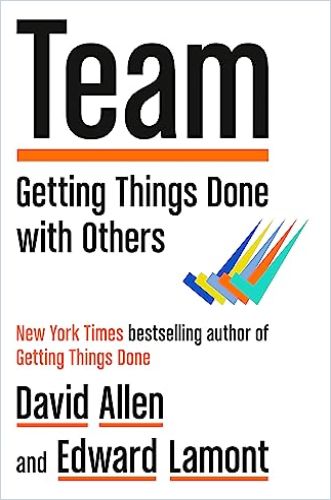An increasing emphasis on teamwork, autonomy, adaptability, and agility has intensified stress and overwhelm for many workers. Productivity guru David Allen and executive coach Edward Lamont offer an antidote: a system to make teamwork orderly, productive, sustainable — and maybe even fun.

Teamwork Without Tears
In 2001, David Allen published Getting Things Done: The Art of Stress-Free Productivity. By 2005, the system had gained such an ardent following that Wired called it “a new cult for the info age,” and Time magazine called Getting Things Done “the self-help business book of its time.”
But since 2001, workplace norms have evolved through systems like Agile, Scrum, Kanban, and Lean to become increasingly team-oriented, adaptive, and flexible. These changes have had radical repercussions for workers: In the absence of a well-defined plan for collaborating productively with one another — particularly as team interactions become more virtual — this new world of work often feels chaotic and overwhelming.
In designing teams, we need to remove the things that get in the way of their members doing their real work and create environments that allow them to perform at their best.
Allen’s extension of the GTD system for teams offers hope. Writing with executive coach Edward Lamont, Allen applies the original GTD framework to teams, with the aim of boosting productivity and helping people achieve a healthy work-life balance, or, as Allen calls it, “healthy high performance”: team-level performance that enables business success while also being sustainable and even fun for team members. Allen and Lamont suggest that the same processes and practices that lead to high performance also support and enhance people’s well-being.
Simple Steps to Foster Focus
Allen and Lamont outline a workflow consisting of the same five steps as the original GTD system, adapted to the needs of teams:
- “Capture” — Team members gather information, developments, or updates that might be of interest to the team, either adding them to a shared team agenda or putting them into their personal agendas to bring them up at a team meeting.
- “Clarify” — As a group, the team determines how to handle an item captured by considering its nature, whether it’s actionable, what the next step should be, what the desired outcome is, and who ought to perform which task by what deadline.
- “Organize” — The team maintains relevant information in a form that’s accessible to all, such as a master calendar for tracking deadlines. Some teams appoint an individual to keep information organized.
- “Reflect” — The team regularly reflects on the outcomes of projects and activities, such as meetings, in order to learn lessons and maintain focus.
- “Engage” — The team sets priorities collectively, sorting tasks into categories according to their importance and urgency.
Long-Term Engagement, Constant Agility
The GTD workflow helps a team clarify its most important tasks and keep track of progress in the here and now. To ensure long-term engagement, Allen and Lamont also provide a team version of the “Horizons of Focus” system from the original GTD framework. This system begins with defining purpose and principles — “What problem do we solve in the world?” — and moves step by step through vision — “What do we want to be true on this team in three to five years?” — to goals, and finally to specific areas of focus for each team member.
However, many team leaders are guilty of overplanning, according to Allen and Lamont, likely because people want a sense of control over the future, even when they know that’s not how life — or business — works. A month spent choosing organizational targets and budgeting for each department is likely a month wasted in today’s “volatile, uncertain, complex, and ambiguous” (VUCA) world. Teams must be able to adapt quickly in the face of change and unforeseen challenges.
Organizational success comes down to the ability to plan quickly, prioritize on the fly, and then execute on those priorities.
To support agility, Allen and Lamont offer a framework called the Natural Planning Model — another adaptation from the original GTD system. Allen first introduced the Natural Planning Model in 1989, aiming at clarity and efficiency in planning. Today, he highlights how it enables teams and individuals to plan dynamically and flexibly. The model keeps planning time to a minimum — its steps can be accomplished in as little as 15 minutes — and empowers team members to take action quickly and confidently. First, establish your purpose and principles. Next, clarify your team vision and define what success would look like. Then brainstorm ideas as a team, exploring wide-ranging possibilities. Organize the best ideas to help the team visualize a project’s priorities and sequence. Finally, identify actionable elements of the emerging plan. Decide what steps to take and who will be responsible for taking those actions.
Delegate and Nurture
Allen and Lamont also offer insights on leadership and culture. They highlight the importance of delegation, which permits a leader to focus on the tasks no other team member can do — including keeping tabs on what’s happening in the company as a whole and spotting upcoming risks and opportunities. Delegation also gives team members the chance to grow their skills.
Allen and Lamont underscore the leader’s role in creating a culture that inspires high performance and supports employee satisfaction. To build a healthy culture, they offer recommendations such as respecting team members’ work-life balance — say, by refraining from sending work emails after hours. They also suggest supporting your people by investing in their physical environment. For example, consider offering people the option of working in a quiet room, away from the hustle and bustle of common areas, when they need to focus.
For the good of the team, someone needs to be standing apart like a meerkat on a mound, listening and looking for patterns in what is coming in across the business.
The GTD system can seem complicated, and Allen argues that it’s necessarily complex because the workplace itself is complex. Yet its steps aren’t arcane or difficult to understand. The power of the system lies in applying it as a whole, consistently, as a set of routines.
Allen has said his purpose in formulating the original GTD system was to free his mind from distractions so he could focus on the single task before him. Almost a quarter of a century later, Allen’s mission seems more vital than ever, given today’s always-on work culture, omnipresent notifications, and never-ending distractions. For teams struggling for clarity and focus — and their leaders — applying Allen and Lamont’s ideas might just change their lives.













